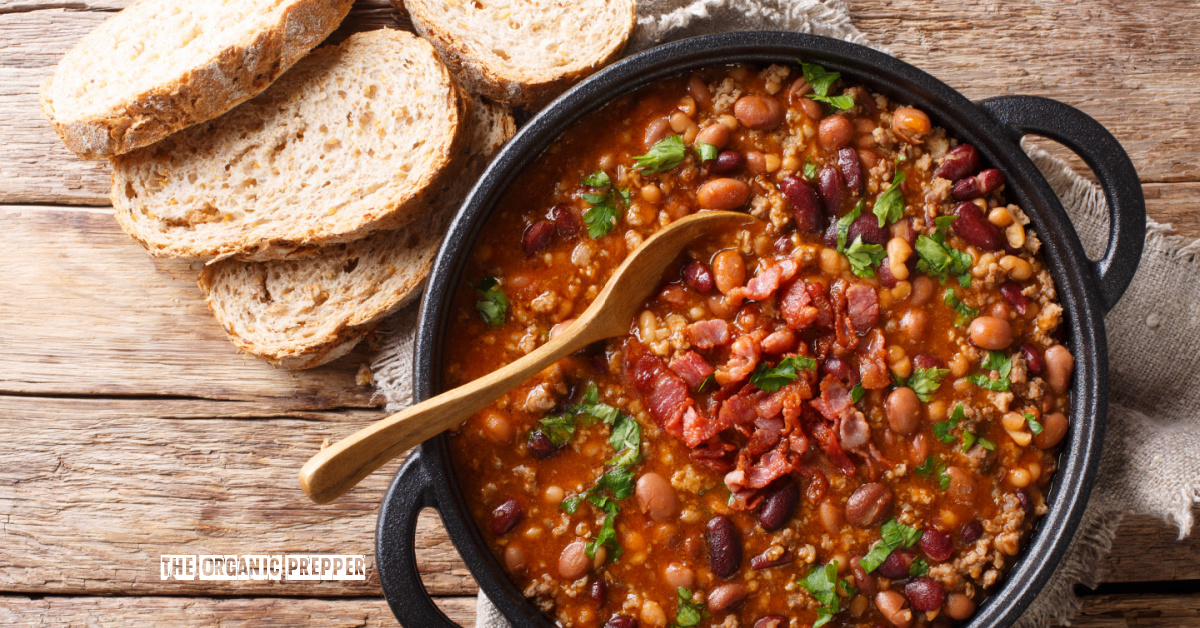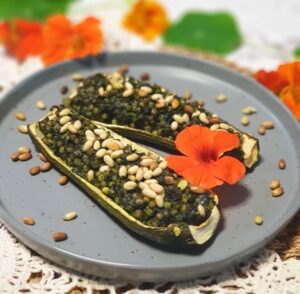(Psst: The FTC wants me to remind you that this website contains affiliate links. That means if you make a purchase from a link you click on, I might receive a small commission. This does not increase the price you’ll pay for that item nor does it decrease the awesomeness of the item. ~ Daisy)
Author of How to Prep When You’re Broke and Bloom Where You’re Planted online course
There are tons of charts out there that will tell you how many calories your family might need when you rely on your food pantry, and they can be very helpful. But sometimes, translating that into actual meals is a little bit tricky. After all, you don’t want to end up eating canned peaches, tuna fish, and french-fried onions for dinner. It’s important to create meals, not just stash food.
Here’s a way to work on building your food supply so that you’re sure to have balanced meals that your family will enjoy.
I like to create meals
This may not sound exactly groundbreaking, but my favorite way to build and maintain my food supply is by building MEALS, not simply stockpiling random foods.
Here’s an example.
A favorite meal of ours is a pot of chili with a loaf of homemade bread. The basic ingredients fresh are:
- Ground beef
- Can of crushed tomatoes
- Can of pinto beans or kidney beans
- Bell pepper
- Onion
- Spices
- Flour
- Yeast
- Sugar
- Salt
- Water
So, if I wanted to make the same meal shelf-stable, I’d replace the ground beef, the bell pepper, and the onions with freeze-dried versions. These can be acquired already freeze-dried – you can get ground beef, bell pepper, and onion in #10 cans. But to save more money and still get the same great flavor, I generally use dehydrated peppers and onions. I either dehydrate it myself or buy it already dehydrated. You can also pressure-can ground beef to use in recipes – the instructions are in this book.
Obviously, the ingredients above can be used in more than just chili – they’re also prime ingredients for spaghetti sauce, sloppy joes, and many more meals.
Plan an emergency food menu
You can plan a menu to base your stockpile around using your family’s favorite meals as inspiration. When you’re cooking, think about how you could translate what you’re making into a shelf-stable meal.
- Could you make it ahead of time and pressure can it? (I explain how to safely can your own recipes here.)
- Could you substitute the perishable ingredients for shelf-stable ones using freeze-dried or canned goods?
- Are there any meals that highlight beans as the protein source that your family loves? That’s a thrifty way to make a shelf-stable meal. Think about baked beans, black bean enchiladas, minestrone, Cajun red beans and rice, lentil casserole, chickpea curries, and more.
Try to come up with 10-20 favorites that you can use in a rotation at a time you’re relying on your pantry.
Now, break it all down.
- Write down your favorite recipes, including quantities, and note how many servings YOUR family gets from this meal. I never go by what the cookbooks say for the number of servings – I base it on what my family actually eats.
- Next, review the recipe and determine how to make it shelf-stable. Canned goods (either home or storebought), alternative proteins (like beans instead of meat), freeze-dried food, and dehydrated goods are all options.
- Calculate the ingredients you need, then break it down into the number of meals it will provide for your family.
Remember, you won’t be using an entire #10 can of freeze-dried beef for one meal. Freeze-dried beef in a #10 can will make the equivalent of 22 four-ounce servings of ground beef. So that can will be able to be used for multiple meals.
When you put your goods away, you can group them into ingredients for meals or put them into categories. But if you’re building your pantry by creating meals, it’s very important to keep a running inventory and replenish as needed. You don’t want to use up all your canned crushed tomatoes during good times and leave yourself lacking during bad times.
Here’s what it might look like if you were grouping it by meals. Using a cardboard box, add:
- #10 can of ground beef
- 12 cans of pinto or kidney beans
- 6 cans of crushed tomatoes
- Packets of dehydrated onions and bell peppers
With that, you’ve got approximately six pots of chili. If you want, you can write the name of the meal and the number of servings on the outside, and you can even print off the recipe.
Create meals to organize your existing supplies
Before you drop huge amounts of cash, go through your existing supplies and group them into meals. You’ll probably find that you’re missing some important ingredients for most meals, but by grouping things together ahead of time, you’ll be able to easily fill in those gaps just a little bit at a time.
Maybe you need some freeze-dried or canned chicken to go into your famous chicken-rice casserole.
You might not have enough split peas to go with your shelf-stable smoked pork for multiple batches of soup.
Are you short on seasonings? Veggies? Protein?
By breaking things down into meals it will be very clear what you need.
There are a lot of different ways to build a pantry.
You may have a different theory for pantry building, and that’s absolutely fine – we should all do what works for us. I don’t rely solely on creating meals, but it’s a big part of my strategy. I love that it provides some comfort and continuity and it also helps me to focus my dollars and efforts in a way that I know my family will enjoy. If you’re looking for more pantry-building ideas, check out this article.
Do you have any shelf-stable meal ideas to share in the comments? Do you build your pantry meal by meal, or do you go about it differently?
Let’s discuss it in the comments section.
About Daisy
Daisy Luther is a coffee-swigging, adventure-seeking, globe-trotting blogger. She is the founder and publisher of three websites. 1) The Organic Prepper, which is about current events, preparedness, self-reliance, and the pursuit of liberty; 2) The Frugalite, a website with thrifty tips and solutions to help people get a handle on their personal finances without feeling deprived; and 3) PreppersDailyNews.com, an aggregate site where you can find links to all the most important news for those who wish to be prepared. Her work is widely republished across alternative media and she has appeared in many interviews.
Daisy is the best-selling author of 5 traditionally published books, 12 self-published books, and runs a small digital publishing company with PDF guides, printables, and courses at SelfRelianceand Survival.com You can find her on Facebook, Pinterest, Instagram, and Twitter.

















